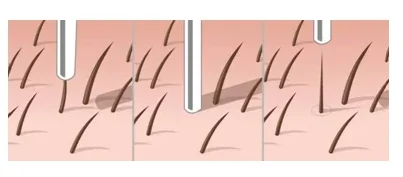
DHT (dihydrotestosterone) is the primary contributing factor in male pattern baldness. DHT, an androgenic hormone, is normally produced by the body and are important for normal male sexual development before birth and during puberty. Male pattern baldness is caused by a genetic sensitivity of hair follicles to DHT. This hormone causes follicles to shrink or “miniaturize”. In turn, this shortens their lifespan and prevents them from producing hair normally.
Thinning hair in most women has no apparent contributing factor as male pattern baldness. Women with hair loss generally are afflicted by diffuse thinning everywhere in the scalp as opposed to a specific pattern.This thinning hair is typically momentary and can result from lots of conditions linked to the actions of hormones, as well as: thyroid conditions, pregnancy, and menopause. Where sickness or hidden hormonal factors are not the cause, DHT acting on an excess of androgen receptors in hair follicles likewise may seem the suspect in thinning hair in women.
As your hair starts to grow sparse and bald, a hair transplant may be the only way to fill those areas before they become significantly visible. The best thing about it is that it’s your own hair.The crucial thing to bear in mind is that hair transplants can only transfer hair from areas that are unaffected by hair loss to the part of the scalp that needs restoration.It’s vital that you realize that all hair transplant techniques use your existing hair. The purpose of a hair transplant is to find the most efficient uses for existing hair. Hair transplant candidates need to have healthy hair growth at the back and sides of the head to function as donor areas. Donor areas are the areas on the head from which grafts and flaps are obtained.Remember, there are limits to what can be accomplished. Anyone with very little hair may not be advised to undergo hair replacement surgery.
Hair Transplant – Follicular Unit Extraction (FUE)

Hair Transplant -Follicular Unit Transplantation (FUT)
This can be achieved by using naturally occurring clusters of 1, 2, 3, or 4 hairs, called follicular units. After the patient’s scalp is anaesthetized, the physician removes a strip of tissue from the donor area from an area within the permanent zone. The donor strip slivered into several independent follicular units by means of microscopic dissection techniques.
As these follicular unit grafts readied, the physician makes a small incision in the scalp, called recipient sites, where the grafts are placed.


EverythingYou Need to Know About Hair Transplant Treatment
A receding hairline or balding is a condition that may occur in both genders, but it is more common in males. Medical supplements and specific treatments may help reduce the speed of receding and increase hair growth. Multiple factors, such as genes, hormones, age, and medical conditions, can be a reason for balding. Massive hair loss can significantly impact your life, both physically and emotionally. Hair transplant, a type of hair growth treatment, can produce and increase hair growth by transplanting healthy hair follicles to a weakening or balding portion of the head. Baldness can’t be cured, but medications and treatments like hair transplants may proficiently address hair fall and hair loss problems.
The WEA Clinic is the best place to get hair growth treatment in Chennai. With the help of the experts, WEA Clinic quickly earned the name of the best hair transplant clinic in Chennai. This minimally invasive procedure can offer a natural-looking and long-lasting solution for hair loss.
Causes of Hair Loss
Hair loss can be emotionally painful and may result from various factors. Understanding these causes can help determine the best course of action for treatment and prevention. Here are some of the common causes of hair loss.
Genetics:
Androgenetic Alopecia: which is hereditary and is referred to as both male-pattern baldness and female-pattern baldness, is the most common cause of hair loss.
Changes in Hormones:
Menopause: Hormonal changes during menopause can also contribute to thinning hair.
Pregnancy and Childbirth: Hormonal imbalances during and after pregnancy can be the reasonfor temporary hair loss.
Thyroid Problems: Both hyperthyroidism and hypothyroidism can disturb hair growth.
Nutritional Deficiencies:
Iron Deficiency: Anaemia can lead to hair thinning.
Protein Deficiency: Hair is generally made of protein, so a diet deficiency can be the main reason for hair loss.
Vitamins and Minerals: Deficiencies in vitamins like B12 and D and minerals like zinc can also cause hair loss.
Lifestyle Factors:
Smoking and alcohol: These can potentially impact blood circulation and hair growth.
Poor Diet: An unhealthy diet lacking effective nutrients can disturb hair health.
Environmental Factors:
Pollution: Exposure to pollutants and toxins can impact scalp health and hair growth.
Seasonal Changes: Some people face more hair fall during certain seasons.
DHT (dihydrotestosterone) is the first contributing factor in male pattern baldness. DHT, an androgenic hormone, is normally generated by the body and is crucial for general male sexual evolution before birth and during puberty. Genetic sensitivity of hair follicles to DHT, which causes male pattern baldness.
Weakening hair in most women has no apparent promoting factor for male pattern baldness. Women with hair loss are commonly impaired by diffuse weakening everywhere in the scalp, as opposed to a particular pattern. This weakening of hair is generally momentary and can result from many conditions connected to the actions of hormones, thyroid conditions, pregnancy, and menopause. Where sickness or hidden hormonal factors are not the reasons, DHT acting on an excessive androgen receptor in hair follicles likewise may seem to be the culprit in the weakening of hair in women.
What is a Hair Transplant?
Scalp sensitivity, sunburn, and inflammation due to increased scalp exposure and reduced insulation are familiar physical impacts of thin hair or baldness. Emotionally, you may lose confidence and increase social anxiety, and you may refuse to go outside or intentionally wear caps to hide your baldness.
A hair transplant is an advanced, minimally invasive treatment in which a plastic surgeon or dermatologist transplants hair to a bald area of the head. It can be performed when a person has excessive hair loss in the head. Cosmetics and skin physicians generally connect hair transplants to improved self-esteem. The physician generally transplants healthy hair follicles from the back or side of the head to the front or top of the head.
What Happens During the Treatment?
After cleaning the scalp, the physician will handle a tiny needle to anaesthetize an area of the head. The two most familiar treatments for implanting healthy hair follicles for hair transplantation are FUT and FUE. The physician will use a scalpel to slit a strip of scalp skin from the back of the head for follicular unit transplantation (FUT). The cut is a few inches long. Stitches are required to close it.
The physician dissects the scalp into tiny sections using a magnifying lens and a surgical knife. Once inserted, these bits help increase natural-looking hair. In follicular unit extraction (FUE), hair follicles are extracted from the back of the head through hundreds to thousands of small punch incisions. The physician will use a razor or a needle to make small holes in the scalp to proceed with a hair transplant. The physician will transplant the hair into these openings. The physician can transplant hundreds or even thousands of hairs during a single session. Grafts and bandages will preserve the scalp for several days after treatment.
After surgery, the physician will remove the stitches in about ten days. To regrow hair fully, it may require three or four sessions. The physician will schedule sessions over a few months to confirm that every transplant heals properly. At WEA Clinic, our doctors specialise in offering hair transplant treatment for both genders, from the early stages of hair loss to the advanced stages.
At WEA Clinic, we offer personal consultations to examine the major cause of your hair loss and develop a personalised treatment plan. Our team of experts provides permanent solutions to assist you in achieving healthy and vibrant hair. If you are experiencing hair loss, we recommend consulting with our healthcare doctors or dermatologists at the WEA clinic. At WEA Clinic, we follow the most familiar types of hair transplant procedures, including follicular unit transplantation (FUT) and follicular unit extraction (FUE). Both treatments involve transplanting hair follicles, but they differ in their methods and the way the follicles are gained and implanted.
Nowadays, hair loss is a common problem among men and women. Research studies in India report that 40% to 45% of adult women experience conditions like receding hairlines, hair thinning, and hair loss. As for the men, about 80% to 85% apparently have male pattern baldness and hair loss.
Hair Transplant Treatments in the WEA Clinic
At WEA Clinic, we have the best team of hair transplant dermatologists who are experts in hair transplantation treatments. Hair transplant dermatologists can work with several treatments to uproot and transplant huge numbers of hair follicles called follicular units. We offer two types of hair transplant techniques based on your preferences and needs. They are:
1. The FUE, Follicular Unit Extraction
Follicular unit extraction (FUE) hair transplants are completed by analysing and picking up the individual hair follicles from the skin and inserting them anywhere on the scalp where hair is thinner or absent. FUE has become more popular than the (FUT) follicular unit transplantation technique. This procedure involved taking a complete piece of skin or scalp, along with the hair follicles, and transplanting the piece to the target area. It also won’t cause a large scar like FUT does. The best patient for a FUE hair transplant is someone with weakening or balding hair who still has plenty of hair nearby to utilise for treatment. It may not be suitable for a FUE hair transplant if you don’t have plenty of healthy or strong hair to transfer to the weakening or balding area. Dermatologists handle micropunches to extract single follicles and depart them, leaving behind almost no signs of extraction.
How Does It Work?
As you get older, the three-phase chain of hair growth and regrowth shortens until follicles no longer regrow hairs. This process differs for everyone. Some people begin balding in their 20s, while others bald much later in life. FUE hair transplants restore hair by switching these old follicles with new ones that can still grow hair. After the hair transplant, the follicles will be nourished by blood vessels, initiating hair growth in the area that previously had weakened hair or balding.
Safety:
The FUE treatment is considered safe, with minor possible side effects, such as small white scars where hair follicles were extracted. In rare cases, infection or tissue death can occur where the operation was performed. It may have temporary side effects that go away several days after treatment. Side effects may include swelling, discoloration, and sensitivities.
Convenient:
FUE is done in multiple 2 to 4-hour sessions over the course of several days. In rare cases, a “mega session” may last 10 to 12 hours. FUE is an outpatient treatment, so can normally go home after the procedure. After FUE, don’t have to disturb the daily routine too much. But don’t soak the area in water or do any extreme exercise for a week.
Effectiveness:
After the hair transplant, a new area of the body gradually starts to grow hair in about 3 to 4 months. You can expect about 10% to 80% of the transplanted hair to grow back.
Are There Any Side Effects Behind The FUE?
After the FUE hair transplant, you won’t experience any scars other than small white dots where follicles were removed, which may fade over time.
Consult the dermatologist if find any of the following side effects:
· Symptoms of infection
· Swelling around the surgery portion
· Follicle swelling (folliculitis)
· Bleeding from the surgery portion
· Differ from the transplanted hair and existing hair in and surrounding the treatment portion.
· Balding or weakening continues even after the hair transplant.
2. The FUT, Follicular Unit Transplantation
Follicular unit transplantation (FUT) and further hair transplants are minimally invasive surgeries to help layer the bald spots caused by hair loss. In FUT surgery, a dermatologist slits a strip of skin from the back or side of the head and pulls a person’s hair follicles. The strip normally doesn’t exceed 1 to 1.5 centimetres broader. Once the individual follicles are taken out of the strip, they’re re-inserted into the scalp. These follicles are implanted into the balding parts of the scalp. The surgery works best at layering a diminishing hairline, the vital cause of male pattern baldness.
Follicular Unit Transplantation (FUT) is an effective hair transplant method referred to as the strip technique. This treatment clears a strip of skin from the sides or back of the scalp where the hair is strengthened, dense, and bald. The strip is then split into tiny grafts, each consisting of one to four hair follicles.
The grafts are then started in the weakening or balding areas of the scalp using small incisions. FTU leaves a linear scar on the donor area and has a longer healing time.
How Does It Work?
During FUT, a physician cuts a strip of skin from the scalp, gradually from the back of the head. The accurate size of the strip is based on the number of follicles needed to conceal bald spots. The strip casually doesn’t exceed 1 to 1.5 centimetres broader. Once the individual follicles are removed from the strip, they’re re-implanted into the scalp. Hair transplant surgeries take from 4 to 8 hours. FUT surgery is commonly faster than FUE surgery. Most people are in an awakened state during the surgery with local anaesthesia that freezes their scalp.
FUT Potential Side Effects
Complications after FUT are rare. The large supply of blood to the head allows it to heal quickly and helps protect it from infections. Less than one percent of people increase the infection from the surgery.
Some potential complications include:
· Unnatural-looking hair
· Scarring
· Irritation of hair follicles (folliculitis)
· Bleeding
· Swelling
· Pain
· Numbness
· Cysts
Safety:
FUT surgery is usually considered cautious and can create a natural-looking result if done properly by a trained physician, with minor possible side effects that cause a scar at the portion of hair extraction, so if people normally have short hair, the FUE surgery process might be a good option.
FUT vs. FUE Hair Transplant
FUT and FUE both involve transplanting every individual hair follicle. During FUT surgery, a dermatologist slits a line of skin from the back or side of your scalp and then pulls the follicles. In FUE surgery, the dermatologist will remove individual hair follicles completely from the scalp rather than first taking a strip of scalp skin.
FUE is currently the more common surgery. Some of the advantages of FUE include:
· Faster healing time
· Minimal pain after surgery
· Doesn’t cause a scar
· Hair from other body parts can be utilised.
· It can be supported for poor hair density patients.
Benefits of Our Hair Transplant in Chennai
· Improved appearance: Our hair transplant clinic in Chennai can increase your appearance by regaining your natural hairline and filling in the bald patches. This could make you look more beautiful.
· Refix hair in bald spots: Our hair transplant treatment will restore hair in areas where natural growth has terminated. You don’t have to worry about your baldness or conceal it with wigs or hats.
· Generate confidence: Our hair transplant treatment can assist you in developing your pride and confidence levels, as hair loss can impact your emotional and psychological life. This treatment will help you to experience confidence and comfort in your professional and social well-being.
Why Choose a WEA Clinic for Hair Transplant in Chennai?
· The WEA Clinic offers the latest hair transplant techniques, such as FUT (follicular unit extraction) and FUE (follicular unit extraction).
· We have a team of well-prepared and highly skilled hair transplant specialists who have attended thousands of successful hair transplant treatments for both genders.
If you want to hair transplant treatment in Chennai, contact WEA Clinic, one of the best hair transplant clinics in the city. If you want to upgrade your life to the next level and say goodbye to wearing wigs and caps, contact us at 8270582706 or contact@weaclinic.com today for advanced hair transplant treatment.

